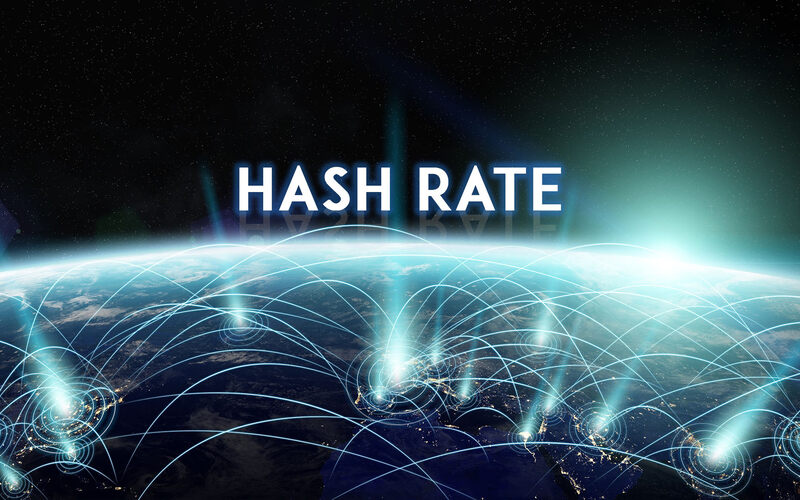
What is Hashrate? Its role in the Crypto world
What is Hashrate? This is a crucial concept in the cryptocurrency world, especially for coins that utilize the Proof of Work (PoW) consensus mechanism like Bitcoin. However, not everyone fully comprehends the nature and role of this term. Let’s find out the details in this article.
What is Hashrate?
Hashrate, also known as hash rate, is a measure representing the computing power of a system or network of computers in processing hash algorithms. In other words, it indicates the speed at which a computer or network can perform complex calculations to solve cryptographic problems.
In the cryptocurrency realm, Hashrate is particularly important for coins employing the Proof of Work (PoW) consensus mechanism, with Bitcoin being a prime example. Miners utilize their computing power to compete in solving hash problems, and the winner gains the right to add a new block of transactions to the blockchain and receive a reward. The higher the Hashrate, the greater the miner’s chances of winning.
In essence, Hash rate is a vital indicator reflecting the computing power of a blockchain network, directly impacting the security, mining difficulty, and value of cryptocurrencies.
How Hashrate works
To gain a deeper understanding of Hash rate, we need to explore its operational mechanism. The process of cryptocurrency mining, particularly for coins using the Proof of Work (PoW) consensus mechanism like Bitcoin, can be visualized as a competitive race among miners.
In this race, the objective of each miner is to discover a special value called a “nonce.” This nonce, when combined with the data of the current transaction block, is fed into a hash function to generate a hash result – a string of characters with a fixed length.
However, not every nonce is acceptable. The system sets a target value, and the generated hash must be less than or equal to this value. Each time a miner changes the nonce, a new hash is produced. Therefore, to find a suitable nonce, miners must perform billions, or even trillions, of calculations per second.
Hash rate is precisely the measure of the speed at which these calculations are executed. In other words, the higher the Hash rate, the more nonces a miner can try in a second, increasing their chances of finding a suitable nonce and winning the right to add a new block of transactions to the blockchain.
When a miner discovers a nonce that meets the requirements, they broadcast this new block to the entire network. Other nodes verify the block’s validity, and if everything is correct, the new block is added to the blockchain. The winning miner receives the block reward, including transaction fees and a certain amount of newly created cryptocurrency.
This process not only generates new coins but also helps validate and secure the network. By continuously solving hash problems and adding new blocks to the blockchain, miners ensure that all transactions are recorded and cannot be altered, establishing trust and transparency for the cryptocurrency system.
The importance of Hash rate
Hashrate plays a critical role in the cryptocurrency world, especially for networks utilizing the Proof of Work (PoW) consensus mechanism. Its significance is evident in the following aspects:
Network security
High Hashrate significantly enhances the security of the blockchain network. To execute a 51% attack, an attacker would need to control more than 50% of the network’s hashrate. With a high Hashrate, this becomes extremely difficult and costly, requiring immense resources. Therefore, a high Hashrate acts as a robust barrier against potential attacks, ensuring the integrity and immutability of the blockchain.
Mining difficulty
Hashrate has a direct relationship with mining difficulty. As Hashrate increases, the mining difficulty automatically adjusts upward to maintain a stable block creation time (e.g., around 10 minutes for each Bitcoin block). This guarantees that the creation of new coins occurs at a predictable rate, preventing inflation and maintaining the scarcity of the cryptocurrency.
Transaction speed
Although not directly, a high Hashrate indirectly contributes to increased transaction processing speed. With more miners participating in the network, the ability to verify and add new transactions to the blockchain improves. This leads to faster transaction confirmation times and a smoother user experience.
Network health and growth
Hashrate is considered a crucial indicator for assessing the health and growth of a blockchain network. A continuously increasing Hashrate demonstrates growing interest and investment in the network, reflecting the community’s confidence in its potential. This attracts more participants, from miners to developers and users, creating a positive cycle that fuels the ecosystem’s development.
Decentralization
A high Hashrate contributes to the network’s decentralization. When computing power is widely distributed among numerous miners, no single individual or entity can control the network. This ensures that the blockchain remains an open and transparent system where everyone has an equal voice.
Factors influencing Hash rate
The Hashrate of a blockchain network is influenced by various factors, including both technical and market elements. Here are some of the key factors:
Mining hardware
- Processing power: The performance of mining devices, particularly specialized processors like ASICs, directly impacts the hashrate. More powerful devices can perform more hash calculations per second, contributing to an increased overall hashrate.
- Number of devices: The number of mining devices operating on the network also affects the hashrate. The more devices participate, the higher the Hashrate.
- Energy efficiency: Mining devices consume electricity to operate. Higher energy efficiency helps reduce mining costs and encourages more participation, thereby increasing the Hashrate.
Mining software
- Mining algorithm: The efficiency of the mining algorithm influences the speed of hash calculations. More optimized algorithms can increase the hashrate without requiring hardware changes.
- Optimization software: Mining software can be optimized to maximize hardware utilization, thereby improving the hashrate.
Market factors
- Cryptocurrency value: The value of the mined cryptocurrency affects mining profitability. Higher prices incentivize more people to participate in mining, leading to an increased hashrate.
- Electricity costs: Electricity costs are a significant factor in mining. Lower costs increase profitability and attract more miners.
- Mining difficulty: Mining difficulty is automatically adjusted to maintain a stable block creation time. Higher difficulty demands more computing power, which can decrease the hashrate if miners don’t upgrade their equipment.
- Regulations: Regulations regarding cryptocurrency mining can impact the hashrate. Strict regulations may reduce the number of participating miners.
Other factors
- Technological advancements: Developments in hardware and software technology can increase the hashrate by providing more efficient devices and algorithms.
- Economic conditions: The overall economic situation can also influence the hashrate. During economic downturns, investors may show less interest in cryptocurrency mining, leading to a decreased hashrate.
Hash rate and energy consumption
Hash rate and energy consumption are closely intertwined, especially in blockchain networks utilizing the Proof of Work (PoW) consensus mechanism like Bitcoin. The question of what is Hashrate’s impact on energy consumption is a significant one.
The connection
- Increased Hashrate – Increased energy consumption: Achieving a high Hash rate requires numerous mining devices operating simultaneously, and these devices consume a substantial amount of electricity. Therefore, an increase in Hashrate is often accompanied by an increase in energy consumption.
- Mining competition: Competition among miners to solve complex problems and earn block rewards encourages them to invest in more powerful hardware, which consumes more energy.
- Outdated hardware: Older mining devices are generally less energy-efficient compared to newer models. Continued use of these devices contributes to increased overall energy consumption.
Environmental concerns
- Carbon emissions: The high energy consumption of cryptocurrency mining can lead to significant carbon emissions, especially if the electricity source comes from coal-fired power plants. This contributes to climate change and has negative environmental impacts.
- E-waste: Mining devices typically have short lifespans and quickly become obsolete. Improper disposal and handling of these devices can cause environmental pollution and affect human health.
Potential solutions
- Transition to Proof of Stake (PoS): PoS is an alternative consensus mechanism that doesn’t require massive computing power like PoW, resulting in significantly lower energy consumption.
- Utilize renewable energy: Encourage and support the use of renewable energy sources like solar, wind, and hydropower to power mining operations.
- Improve energy efficiency: Develop and utilize more energy-efficient mining devices, minimizing electricity consumption per hash calculation.
- Recycle and manage E-waste: Establish effective e-waste recycling and management processes to reduce environmental impact.
Hash rate plays a vital role in the world of cryptocurrency, influencing the security, stability, and value of coins. Its growth represents the expansion of the community and confidence in the future of cryptocurrency.
However, the challenge of energy consumption remains and needs to be addressed with sustainable solutions. Understanding Hash rate is the first step towards exploring the potential-filled world of cryptocurrency.
This article from Solution Of Blockchain has provided a detailed explanation of “what is Hashrate?”. If you have any further questions related to this topic or the cryptocurrency investment market, please leave a comment below and we’ll be happy to answer them!







